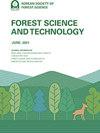Characteristics of forest road cut slopes affecting the movement of mammals in South Korea
IF 2.2
Q2 FORESTRY
引用次数: 3
Abstract
Abstract Existing forest roads that are the base infrastructure foundation for forest management have been built with a focus on structural stability rather than ecological impact. In recent, however, the concerns on the ecological and environmental impacts on the forest road construction has been increased with the emphasis of sustainable forest management and the improvement of public awareness. Especially, the cut slopes that occurred on the forest road construction are known to affect the movement and habitat of wild animals living in the forest. This study aims to establish environmental and structural standards for the cut slopes by identifying the effect of forest road cut slopes on the movement of wild animals based on a survey of national forest roads in South Korea (30 km in total). Seven factors associated with forest road cut slopes, including cut slope length, cut slope gradient, soil type, longitudinal position, crossing position, aspect, and vegetation coverage, as well as wildlife tracks were investigated. As a result of statistical analysis using cross tabulation to determine the correlation of wildlife tracks with each cut slope factor, five factors (soil type, cut slope gradient, cut slope length, vegetation coverage, and crossing position) were significantly identified. Using these five factors, a prediction model to predict whether wildlife move or not on the cut slope was developed, and the discriminant hit ratio was 76.0%. Thus, using such models, there is a need to develop the guidelines of forest road installation considering the wildlife movement and of ecological corridor installation for more eco-friendly forest road construction and design in the future.影响韩国哺乳动物活动的森林路堑斜坡特征
现有森林道路是森林经营的基础设施基础,其建设注重结构稳定性而非生态影响。近年来,随着对森林可持续经营的重视和公众意识的提高,人们对森林道路建设对生态环境影响的关注有所增加。特别是在森林道路建设过程中产生的砍坡影响了森林中野生动物的活动和栖息地。本研究旨在通过对韩国国家森林道路(共30公里)的调查,确定森林道路切割斜坡对野生动物运动的影响,从而建立切割斜坡的环境和结构标准。研究了与森林道路路堑坡度相关的7个因子,包括路堑长度、路堑坡度、土壤类型、纵向位置、交叉位置、坡向、植被覆盖度和野生动物足迹。利用交叉表法对野生动物足迹与各坡面因子的相关性进行统计分析,发现土壤类型、坡面坡度、坡面长度、植被覆盖度和交叉位置5个因子具有显著性。利用这5个因素,建立了野生动物在切坡上是否移动的预测模型,判别准确率为76.0%。因此,利用这些模型,有必要制定考虑野生动物运动的森林道路安装指南和生态走廊安装指南,以便在未来更加环保的森林道路建设和设计。
本文章由计算机程序翻译,如有差异,请以英文原文为准。
求助全文
约1分钟内获得全文
求助全文

 求助内容:
求助内容: 应助结果提醒方式:
应助结果提醒方式:


